
Date: November 1, 2019
Location: Lat: 28.434133°, Long: -79.045533°
Dive Depth Range: 822 - 870 meters (2,697 - 2,854 feet)
Access Dive Summary and ROV Data
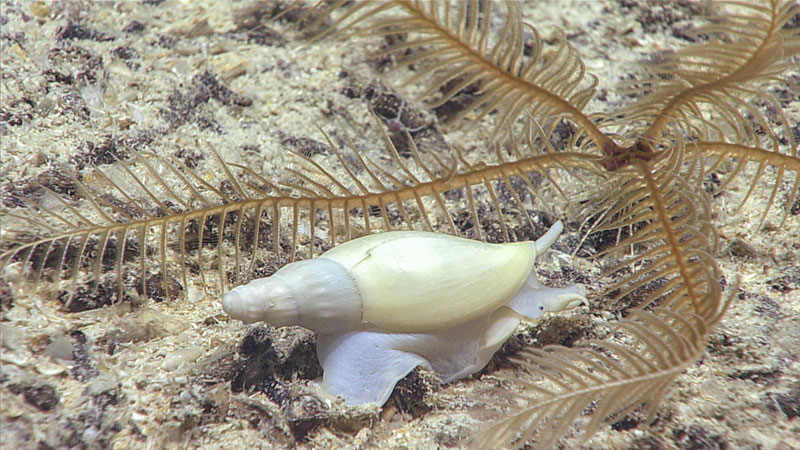
This snail (neogastropod) and feather star (crinoid) pair were spotted during Dive 01 of the 2019 Southeastern U.S. Deep-sea Exploration expedition. Image courtesy of the NOAA Office of Ocean Exploration and Research, 2019 Southeastern U.S. Deep-sea Exploration. Download larger version (jpg, 1.4 MB).
Today’s dive was on the southern Blake Plateau just inside the Stetson-Miami Terrace Deepwater Coral Habitat Area of Particular Concern (HAPC) east of Port Canaveral, Florida. This site was first mapped during Windows to the Deep 2019. The objective of this dive was to acquire data to further characterize this newly acquired multibeam bathymetry. The seafloor bathymetry revealed a series of mound features and larger north/south trending ridges/escarpments. Seafloor features like these can provide suitable habitat for deep-sea coral and sponge communities and their associates. So, this dive was targeted to help provide foundational data needed by the scientific community.
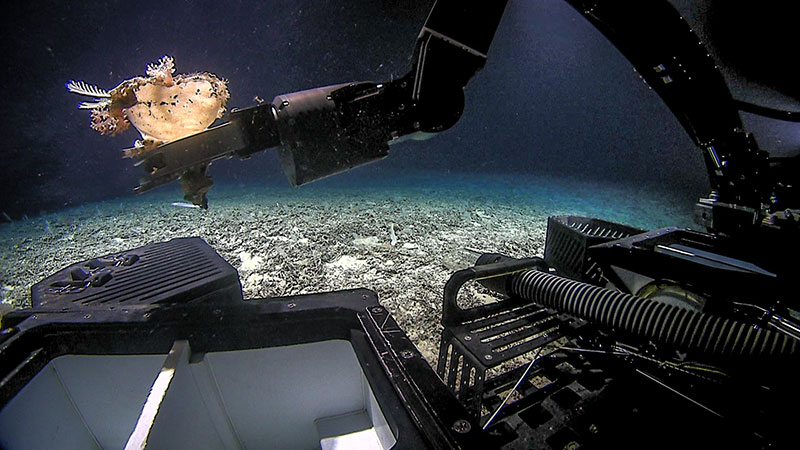
Pilots on board NOAA Ship Okeanos Explorer guide ROV Deep Discoverer’s manipulator arms to grab a sample of a sponge (porifera) and its associates during Dive 01 of the 2019 Southeastern U.S. Deep-sea Exploration expedition. Image courtesy of the NOAA Office of Ocean Exploration and Research, 2019 Southeastern U.S. Deep-sea Exploration. Download larger version (jpg, 1.2 MB).
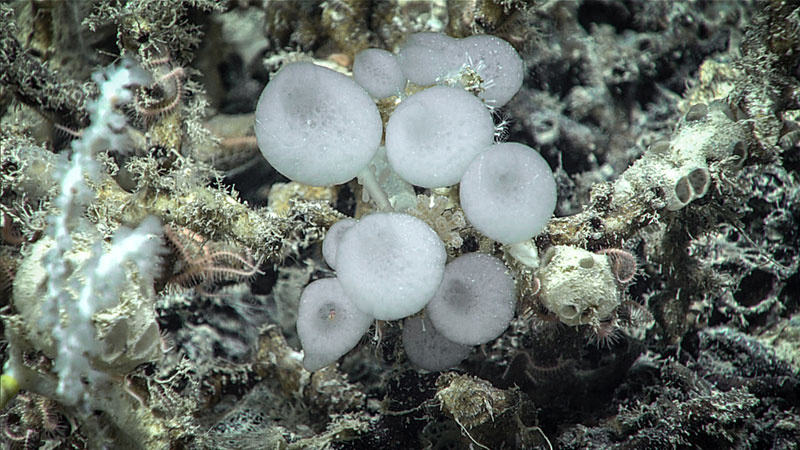
Sponges are home to lots of other invertebrates, which makes them very important to the community. This glass sponge (Sympagella nux) was seen during Dive 01 of the 2019 Southeastern U.S. Deep-sea Exploration expedition. Image courtesy of the NOAA Office of Ocean Exploration and Research, 2019 Southeastern U.S. Deep-sea Exploration. Download larger version (jpg, 1.4 MB).
We began this dive at a depth of 864 meters (~2,835 feet). Remotely operated vehicle (ROV) Deep Discoverer landed on a field of dead Lophelia coral rubble. These fields, the majority of which were covered in a ferromanganese crust, continued throughout most of the dive (there were a few areas of exposed sand waves, which are indicative of current direction and intensity). Closer to the ridge crests, we also observed large karst features.
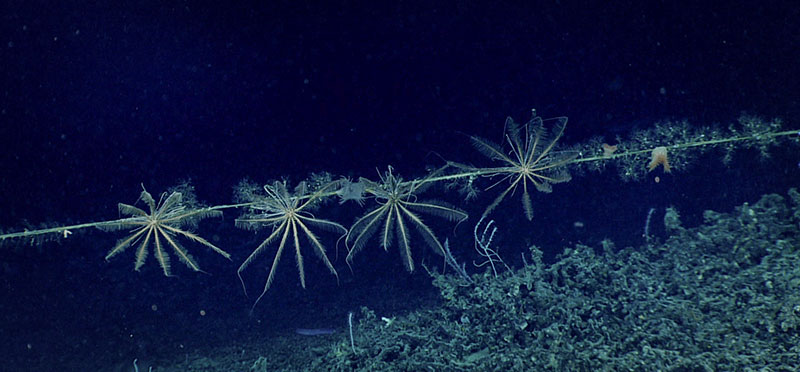
Along the top ridge during Dive 01 of the 2019 Southeastern U.S. Deep-sea Exploration expedition, we found an area with standing dead coral and a ghost net. Approximately five crinoids (Zenometra columnaris), which may represent a new subspecies, were on the rope leading from the net. Image courtesy of the NOAA Office of Ocean Exploration and Research, 2019 Southeastern U.S. Deep-sea Exploration. Download larger version (jpg, 1.3 MB).
As we traveled up slope, we saw larger and denser dead coral frameworks, the presence of a very common feather star (comatulid crinoid) increased, and there was an abundance of sea urchins (Areosoma).
Five samples were collected during the dive using the ROV’s robotic arms and the suction sampler. Among these samples are species of coral and sponges and their associates.
During Dive 01 of the 2019 Southeastern U.S. Deep-sea Exploration, we explored the Stetson-Miami Terrace Deep Water Coral Habitat Area of Particular Concern (HAPC). The largest coral HAPC in the continental United States, it has protected sensitive deep-sea coral and sponge habitat since 2010. This habitat supports a diverse array of invertebrates and fishes, some of which are commercially important. Though vital ecosystems, deep-sea coral habitats are not as well understood as their shallow water counterparts. Increased understanding is key to the sustainable management and protection of these habitats, but first we need to know that they are there. Deep-sea exploration is the first step toward increasing our understanding of these wonderful and diverse habitats. Video courtesy of the NOAA Office of Ocean Exploration and Research, 2019 Southeastern U.S. Deep-sea Exploration. Download larger version (mp4, 60.4 MB).

Location of Dive 01 of the 2019 Southeastern U.S. Deep-sea Exploration expedition on November 1, 2019. Download larger version (jpg, 2.1 MB).
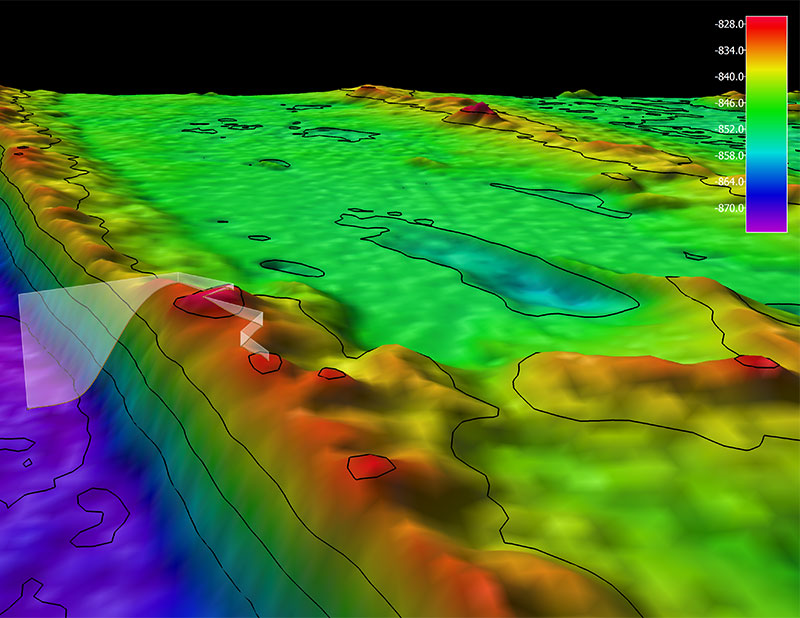
The remotely operated vehicle track for Dive 01 of the 2019 Southeastern U.S. Deep-sea Exploration expedition, shown as an orange line with a white curtain. Legend is water depth in meters. Download larger version (jpg, 4.7 MB).